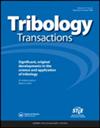缺油润滑下静脉仿生织构圆柱滚子推力轴承系统的摩擦学行为
IF 2.2
3区 工程技术
Q2 ENGINEERING, MECHANICAL
引用次数: 0
摘要
摘要研究了静脉仿生织构圆柱滚子推力轴承各部件的摩擦学行为,揭示了主静脉在缺油润滑条件下对轴承系统摩擦学性能的影响。利用光纤激光打标系统,在圆柱滚子推力轴承轴承座滚道上制备了连翘叶、黄叶、白蜡树叶、白蜡树叶和杏叶5种叶片的2种静脉仿生纹理图案。采用定制的立式万向磨损试验台,对轴承在缺油润滑条件下的摩擦系数进行了测量。分别获得了轴垫圈、保持架和壳体垫圈的磨损量,并对磨损表面进行了表征。结果表明:在缺氧润滑条件下,CRTB系统的总磨损损失主要是保持架的损耗;不同静脉仿生肌理影响下的润滑剂对生成较好的尼龙膜的作用比尼龙粉的用量更显著。此外,无主静脉仿生纹理的尼龙膜面积更大,这与整个CRTB系统的磨损损失有关。由于主静脉产生了良好的二次润滑效果,易于获得具有增强减摩性能的尼龙膜,在缺油润滑条件下,轴承系统的质量损失大大降低。关键词:滚动轴承静脉仿生纹理激光表面纹理摩擦学行为缺乏润滑免责声明作为对作者和研究人员的服务,我们提供这个版本的接受手稿(AM)。在最终出版版本记录(VoR)之前,将对该手稿进行编辑、排版和审查。在制作和印前,可能会发现可能影响内容的错误,所有适用于期刊的法律免责声明也与这些版本有关。本文章由计算机程序翻译,如有差异,请以英文原文为准。
Tribological Behavior for Vein-bionic Textured Cylindrical Roller Thrust Bearing System under Starved Lubrication
AbstractThe aim of the present work was to investigate the tribological behavior for each component of vein-bionic textured cylindrical roller thrust bearings and reveal the influence of chief vein on tribological performance of bearing system under starved lubrication. Two types of vein-bionic texture patterns derived from five kinds of leaves namely Forsythia, Clausena lansium, Ash, Pipal, and Apricot were prepared on the raceway of the shaft washer of cylindrical roller thrust bearings (CRTBs) by a fiber laser marking system. A vertical universal wear test rig with a customized tribo-pair was used to measure the coefficients of friction (COFs) of bearings under starved lubrication. The wear losses of shaft washer, cage, and housing washer were obtained, respectively, and the worn surfaces were characterized. The results show that the total wear losses for CRTB system were dominated by losses of the cage under starved lubrication. The lubricant impacted by different vein-bionic textures play a more significant role in generating the preferable nylon film instead of the amount of nylon powder. Additionally, larger area nylon film was observed for vein-bionic textures with no-chief vein, which correlates with larger wear losses for whole CRTB system. Due to the excellent secondary lubrication effect generated by chief vein, the nylon film with enhanced friction-reduction property can easily obtained, and the mass losses for bearing system were greatly decreased under starved lubrication.Keywords: Rolling element bearingVein-bionic textureLaser surface texturingTribological behaviorStarved lubricationDisclaimerAs a service to authors and researchers we are providing this version of an accepted manuscript (AM). Copyediting, typesetting, and review of the resulting proofs will be undertaken on this manuscript before final publication of the Version of Record (VoR). During production and pre-press, errors may be discovered which could affect the content, and all legal disclaimers that apply to the journal relate to these versions also.
求助全文
通过发布文献求助,成功后即可免费获取论文全文。
去求助
来源期刊

Tribology Transactions
工程技术-工程:机械
CiteScore
3.90
自引率
4.80%
发文量
82
审稿时长
4 months
期刊介绍:
Tribology Transactions contains experimental and theoretical papers on friction, wear, lubricants, lubrication, materials, machines and moving components, from the macro- to the nano-scale.
The papers will be of interest to academic, industrial and government researchers and technologists working in many fields, including:
Aerospace, Agriculture & Forest, Appliances, Automotive, Bearings, Biomedical Devices, Condition Monitoring, Engines, Gears, Industrial Engineering, Lubricants, Lubricant Additives, Magnetic Data Storage, Manufacturing, Marine, Materials, MEMs and NEMs, Mining, Power Generation, Metalworking Fluids, Seals, Surface Engineering and Testing and Analysis.
All submitted manuscripts are subject to initial appraisal by the Editor-in-Chief and, if found suitable for further consideration, are submitted for peer review by independent, anonymous expert referees. All peer review in single blind and submission is online via ScholarOne Manuscripts.
 求助内容:
求助内容: 应助结果提醒方式:
应助结果提醒方式:


